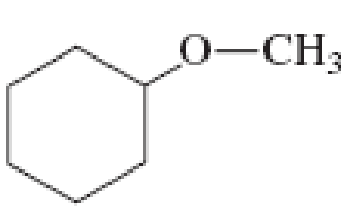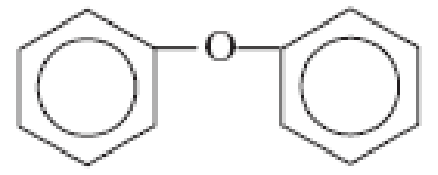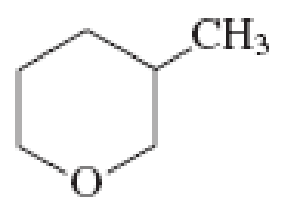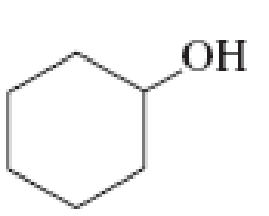
EBK GENERAL, ORGANIC, AND BIOLOGICAL CH
7th Edition
ISBN: 9780100853188
Author: STOKER
Publisher: YUZU
expand_more
expand_more
format_list_bulleted
Textbook Question
Chapter 14, Problem 14.127EP
Classify each of the following molecular structures as that of a cyclic ether, a noncyclic ether, or a nonether.




Expert Solution & Answer
Want to see the full answer?
Check out a sample textbook solution
Students have asked these similar questions
く
Predicting the pr
Predict the major products of the following organic reaction:
Δ
Some important notes:
• Draw the major product, or products, of the reaction in the drawing area below.
• If there aren't any products, because no reaction will take place, check the box below the drawing area instead.
• Be sure to use wedge and dash bonds when necessary, for example to distinguish between major products that are
enantiomers.
?
Click and drag to start drawing a structure.
propose synthesis
Explanation
O Conjugated Pi Systems
Deducing the reactants of a Diels-Alder reaction
Can the molecule on the right-hand side of this organic reaction be made in good yield from no more than two reactants, in one
step, by moderately heating the reactants?
?
Δ
If your answer is yes, then draw the reactant or reactants in the drawing area below. You can draw the reactants in any
arrangement you like.
• If your answer is no, check the box under the drawing area instead.
Click and drag to start drawing a structure.
X
Chapter 14 Solutions
EBK GENERAL, ORGANIC, AND BIOLOGICAL CH
Ch. 14.1 - Prob. 1QQCh. 14.1 - Prob. 2QQCh. 14.2 - Prob. 1QQCh. 14.2 - Prob. 2QQCh. 14.2 - Prob. 3QQCh. 14.3 - Prob. 1QQCh. 14.3 - Prob. 2QQCh. 14.3 - Prob. 3QQCh. 14.3 - Prob. 4QQCh. 14.4 - Prob. 1QQ
Ch. 14.4 - Prob. 2QQCh. 14.4 - Prob. 3QQCh. 14.5 - Prob. 1QQCh. 14.5 - Prob. 2QQCh. 14.5 - Prob. 3QQCh. 14.5 - Prob. 4QQCh. 14.6 - Prob. 1QQCh. 14.6 - Prob. 2QQCh. 14.6 - Prob. 3QQCh. 14.7 - Prob. 1QQCh. 14.7 - Prob. 2QQCh. 14.8 - Prob. 1QQCh. 14.8 - Prob. 2QQCh. 14.9 - Prob. 1QQCh. 14.9 - Prob. 2QQCh. 14.9 - Prob. 3QQCh. 14.9 - Prob. 4QQCh. 14.9 - Prob. 5QQCh. 14.9 - Prob. 6QQCh. 14.10 - Prob. 1QQCh. 14.10 - Prob. 2QQCh. 14.11 - Prob. 1QQCh. 14.11 - Prob. 2QQCh. 14.11 - Prob. 3QQCh. 14.12 - Prob. 1QQCh. 14.12 - Prob. 2QQCh. 14.13 - Prob. 1QQCh. 14.13 - Prob. 2QQCh. 14.13 - Prob. 3QQCh. 14.14 - Prob. 1QQCh. 14.14 - Prob. 2QQCh. 14.14 - Prob. 3QQCh. 14.15 - Prob. 1QQCh. 14.15 - Prob. 2QQCh. 14.15 - Prob. 3QQCh. 14.15 - Prob. 4QQCh. 14.16 - Prob. 1QQCh. 14.16 - Prob. 2QQCh. 14.17 - Prob. 1QQCh. 14.17 - Prob. 2QQCh. 14.17 - Prob. 3QQCh. 14.18 - Prob. 1QQCh. 14.18 - Prob. 2QQCh. 14.18 - Prob. 3QQCh. 14.19 - Prob. 1QQCh. 14.19 - Prob. 2QQCh. 14.20 - Prob. 1QQCh. 14.20 - Prob. 2QQCh. 14.20 - Prob. 3QQCh. 14.20 - Prob. 4QQCh. 14.20 - Prob. 5QQCh. 14.21 - Prob. 1QQCh. 14.21 - Prob. 2QQCh. 14.21 - Prob. 3QQCh. 14.21 - Prob. 4QQCh. 14.21 - Prob. 5QQCh. 14 - Prob. 14.1EPCh. 14 - Prob. 14.2EPCh. 14 - Prob. 14.3EPCh. 14 - Prob. 14.4EPCh. 14 - Prob. 14.5EPCh. 14 - Prob. 14.6EPCh. 14 - Prob. 14.7EPCh. 14 - Prob. 14.8EPCh. 14 - Prob. 14.9EPCh. 14 - Prob. 14.10EPCh. 14 - Write a condensed structural formula for each of...Ch. 14 - Write a condensed structural formula for each of...Ch. 14 - Prob. 14.13EPCh. 14 - Prob. 14.14EPCh. 14 - Prob. 14.15EPCh. 14 - Prob. 14.16EPCh. 14 - Prob. 14.17EPCh. 14 - Prob. 14.18EPCh. 14 - Each of the following alcohols is named...Ch. 14 - Prob. 14.20EPCh. 14 - Prob. 14.21EPCh. 14 - Prob. 14.22EPCh. 14 - Prob. 14.23EPCh. 14 - Prob. 14.24EPCh. 14 - Prob. 14.25EPCh. 14 - Prob. 14.26EPCh. 14 - Prob. 14.27EPCh. 14 - Prob. 14.28EPCh. 14 - Prob. 14.29EPCh. 14 - Prob. 14.30EPCh. 14 - Prob. 14.31EPCh. 14 - Prob. 14.32EPCh. 14 - Prob. 14.33EPCh. 14 - Prob. 14.34EPCh. 14 - Explain why the boiling points of alcohols are...Ch. 14 - Explain why the water solubilities of alcohols are...Ch. 14 - Prob. 14.37EPCh. 14 - Prob. 14.38EPCh. 14 - Prob. 14.39EPCh. 14 - Which member of each of the following pairs of...Ch. 14 - Determine the maximum number of hydrogen bonds...Ch. 14 - Determine the maximum number of hydrogen bonds...Ch. 14 - Prob. 14.43EPCh. 14 - Prob. 14.44EPCh. 14 - Prob. 14.45EPCh. 14 - Prob. 14.46EPCh. 14 - Classify each of the following alcohols as a...Ch. 14 - Classify each of the following alcohols as a...Ch. 14 - Classify each of the following alcohols as a...Ch. 14 - Classify each of the following alcohols as a...Ch. 14 - Prob. 14.51EPCh. 14 - Prob. 14.52EPCh. 14 - Prob. 14.53EPCh. 14 - Prob. 14.54EPCh. 14 - Prob. 14.55EPCh. 14 - Prob. 14.56EPCh. 14 - Prob. 14.57EPCh. 14 - Prob. 14.58EPCh. 14 - Prob. 14.59EPCh. 14 - Prob. 14.60EPCh. 14 - The alcohol 2,2-dimethyl-1-butanol cannot be...Ch. 14 - Prob. 14.62EPCh. 14 - Prob. 14.63EPCh. 14 - Prob. 14.64EPCh. 14 - Draw the structure of the aldehyde or ketone...Ch. 14 - Draw the structure of the aldehyde or ketone...Ch. 14 - Prob. 14.67EPCh. 14 - Prob. 14.68EPCh. 14 - Prob. 14.69EPCh. 14 - Prob. 14.70EPCh. 14 - Three isomeric pentanols with unbranched carbon...Ch. 14 - Prob. 14.72EPCh. 14 - Prob. 14.73EPCh. 14 - Prob. 14.74EPCh. 14 - Prob. 14.75EPCh. 14 - Prob. 14.76EPCh. 14 - Prob. 14.77EPCh. 14 - Prob. 14.78EPCh. 14 - Prob. 14.79EPCh. 14 - Prob. 14.80EPCh. 14 - Prob. 14.81EPCh. 14 - Prob. 14.82EPCh. 14 - Prob. 14.83EPCh. 14 - Prob. 14.84EPCh. 14 - Prob. 14.85EPCh. 14 - Prob. 14.86EPCh. 14 - Prob. 14.87EPCh. 14 - Prob. 14.88EPCh. 14 - Prob. 14.89EPCh. 14 - Prob. 14.90EPCh. 14 - Prob. 14.91EPCh. 14 - Classify each of the following compounds as an...Ch. 14 - Draw or write the following for the simplest ether...Ch. 14 - Draw or write the following for the simplest ether...Ch. 14 - Prob. 14.95EPCh. 14 - Prob. 14.96EPCh. 14 - Prob. 14.97EPCh. 14 - Prob. 14.98EPCh. 14 - Prob. 14.99EPCh. 14 - Prob. 14.100EPCh. 14 - Prob. 14.101EPCh. 14 - Prob. 14.102EPCh. 14 - Prob. 14.103EPCh. 14 - Prob. 14.104EPCh. 14 - Prob. 14.105EPCh. 14 - Prob. 14.106EPCh. 14 - Prob. 14.107EPCh. 14 - Prob. 14.108EPCh. 14 - Prob. 14.109EPCh. 14 - Prob. 14.110EPCh. 14 - Prob. 14.111EPCh. 14 - Prob. 14.112EPCh. 14 - Prob. 14.113EPCh. 14 - Give common names for all ethers that are...Ch. 14 - How many isomeric ethers exist when the R groups...Ch. 14 - Prob. 14.116EPCh. 14 - Prob. 14.117EPCh. 14 - Draw condensed structural formulas for the...Ch. 14 - Prob. 14.119EPCh. 14 - Prob. 14.120EPCh. 14 - Prob. 14.121EPCh. 14 - Prob. 14.122EPCh. 14 - Prob. 14.123EPCh. 14 - How do the chemical reactivities of ethers compare...Ch. 14 - Explain why ether molecules cannot hydrogen-bond...Ch. 14 - How many hydrogen bonds can form between a single...Ch. 14 - Classify each of the following molecular...Ch. 14 - Classify each of the following molecular...Ch. 14 - Prob. 14.129EPCh. 14 - Prob. 14.130EPCh. 14 - Prob. 14.131EPCh. 14 - Draw a condensed structural formula for each of...Ch. 14 - Prob. 14.133EPCh. 14 - Prob. 14.134EPCh. 14 - Prob. 14.135EPCh. 14 - Prob. 14.136EPCh. 14 - Prob. 14.137EPCh. 14 - For each of the following pairs of compounds,...Ch. 14 - Assign an IUPAC name to each of the following...Ch. 14 - Prob. 14.140EPCh. 14 - Prob. 14.141EPCh. 14 - Prob. 14.142EPCh. 14 - Prob. 14.143EPCh. 14 - Prob. 14.144EPCh. 14 - Prob. 14.145EPCh. 14 - Prob. 14.146EP
Knowledge Booster
Learn more about
Need a deep-dive on the concept behind this application? Look no further. Learn more about this topic, biology and related others by exploring similar questions and additional content below.Similar questions
- Diels Alder Cycloaddition: Focus on regiochemistry (problems E-F) –> match + of thedienophile and - of the diene while also considering stereochemistry (endo).arrow_forwardHELP! URGENT! PLEASE RESOND ASAP!arrow_forwardQuestion 4 Determine the rate order and rate constant for sucrose hydrolysis. Time (hours) [C6H12O6] 0 0.501 0.500 0.451 1.00 0.404 1.50 0.363 3.00 0.267 First-order, k = 0.210 hour 1 First-order, k = 0.0912 hour 1 O Second-order, k = 0.590 M1 hour 1 O Zero-order, k = 0.0770 M/hour O Zero-order, k = 0.4896 M/hour O Second-order, k = 1.93 M-1-hour 1 10 ptsarrow_forward
- Determine the rate order and rate constant for sucrose hydrolysis. Time (hours) [C6H12O6] 0 0.501 0.500 0.451 1.00 0.404 1.50 0.363 3.00 0.267arrow_forwardDraw the products of the reaction shown below. Use wedge and dash bonds to indicate stereochemistry. Ignore inorganic byproducts. OSO4 (cat) (CH3)3COOH Select to Draw ઘarrow_forwardCalculate the reaction rate for selenious acid, H2SeO3, if 0.1150 M I-1 decreases to 0.0770 M in 12.0 minutes. H2SeO3(aq) + 6I-1(aq) + 4H+1(aq) ⟶ Se(s) + 2I3-1(aq) + 3H2O(l)arrow_forward
- Problem 5-31 Which of the following objects are chiral? (a) A basketball (d) A golf club (b) A fork (c) A wine glass (e) A spiral staircase (f) A snowflake Problem 5-32 Which of the following compounds are chiral? Draw them, and label the chirality centers. (a) 2,4-Dimethylheptane (b) 5-Ethyl-3,3-dimethylheptane (c) cis-1,4-Dichlorocyclohexane Problem 5-33 Draw chiral molecules that meet the following descriptions: (a) A chloroalkane, C5H11Cl (c) An alkene, C6H12 (b) An alcohol, C6H140 (d) An alkane, C8H18 Problem 5-36 Erythronolide B is the biological precursor of erythromycin, a broad-spectrum antibiotic. How H3C CH3 many chirality centers does erythronolide B have? OH Identify them. H3C -CH3 OH Erythronolide B H3C. H3C. OH OH CH3arrow_forwardPLEASE HELP! URGENT! PLEASE RESPOND!arrow_forward2. Propose a mechanism for this reaction. ہلی سے ملی N H (excess)arrow_forward
- Steps and explanationn please.arrow_forwardProblem 5-48 Assign R or S configurations to the chirality centers in ascorbic acid (vitamin C). OH H OH HO CH2OH Ascorbic acid O H Problem 5-49 Assign R or S stereochemistry to the chirality centers in the following Newman projections: H Cl H CH3 H3C. OH H3C (a) H H H3C (b) CH3 H Problem 5-52 Draw the meso form of each of the following molecules, and indicate the plane of symmetry in each: OH OH (a) CH3CHCH2CH2CHCH3 CH3 H3C. -OH (c) H3C CH3 (b) Problem 5-66 Assign R or S configurations to the chiral centers in cephalexin, trade-named Keflex, the most widely prescribed antibiotic in the United States. H2N H IHH S Cephalexin N. CH3 CO₂Harrow_forwardSteps and explanationn please.arrow_forward
arrow_back_ios
SEE MORE QUESTIONS
arrow_forward_ios
Recommended textbooks for you
 Organic And Biological ChemistryChemistryISBN:9781305081079Author:STOKER, H. Stephen (howard Stephen)Publisher:Cengage Learning,
Organic And Biological ChemistryChemistryISBN:9781305081079Author:STOKER, H. Stephen (howard Stephen)Publisher:Cengage Learning, General, Organic, and Biological ChemistryChemistryISBN:9781285853918Author:H. Stephen StokerPublisher:Cengage Learning
General, Organic, and Biological ChemistryChemistryISBN:9781285853918Author:H. Stephen StokerPublisher:Cengage Learning Chemistry: Principles and PracticeChemistryISBN:9780534420123Author:Daniel L. Reger, Scott R. Goode, David W. Ball, Edward MercerPublisher:Cengage Learning
Chemistry: Principles and PracticeChemistryISBN:9780534420123Author:Daniel L. Reger, Scott R. Goode, David W. Ball, Edward MercerPublisher:Cengage Learning Introductory Chemistry: An Active Learning Approa...ChemistryISBN:9781305079250Author:Mark S. Cracolice, Ed PetersPublisher:Cengage Learning
Introductory Chemistry: An Active Learning Approa...ChemistryISBN:9781305079250Author:Mark S. Cracolice, Ed PetersPublisher:Cengage Learning Chemistry for Today: General, Organic, and Bioche...ChemistryISBN:9781305960060Author:Spencer L. Seager, Michael R. Slabaugh, Maren S. HansenPublisher:Cengage Learning
Chemistry for Today: General, Organic, and Bioche...ChemistryISBN:9781305960060Author:Spencer L. Seager, Michael R. Slabaugh, Maren S. HansenPublisher:Cengage Learning

Organic And Biological Chemistry
Chemistry
ISBN:9781305081079
Author:STOKER, H. Stephen (howard Stephen)
Publisher:Cengage Learning,

General, Organic, and Biological Chemistry
Chemistry
ISBN:9781285853918
Author:H. Stephen Stoker
Publisher:Cengage Learning

Chemistry: Principles and Practice
Chemistry
ISBN:9780534420123
Author:Daniel L. Reger, Scott R. Goode, David W. Ball, Edward Mercer
Publisher:Cengage Learning

Introductory Chemistry: An Active Learning Approa...
Chemistry
ISBN:9781305079250
Author:Mark S. Cracolice, Ed Peters
Publisher:Cengage Learning

Chemistry for Today: General, Organic, and Bioche...
Chemistry
ISBN:9781305960060
Author:Spencer L. Seager, Michael R. Slabaugh, Maren S. Hansen
Publisher:Cengage Learning

07 Physical Properties of Organic Compounds; Author: Mindset;https://www.youtube.com/watch?v=UjlSgwq4w6U;License: Standard YouTube License, CC-BY